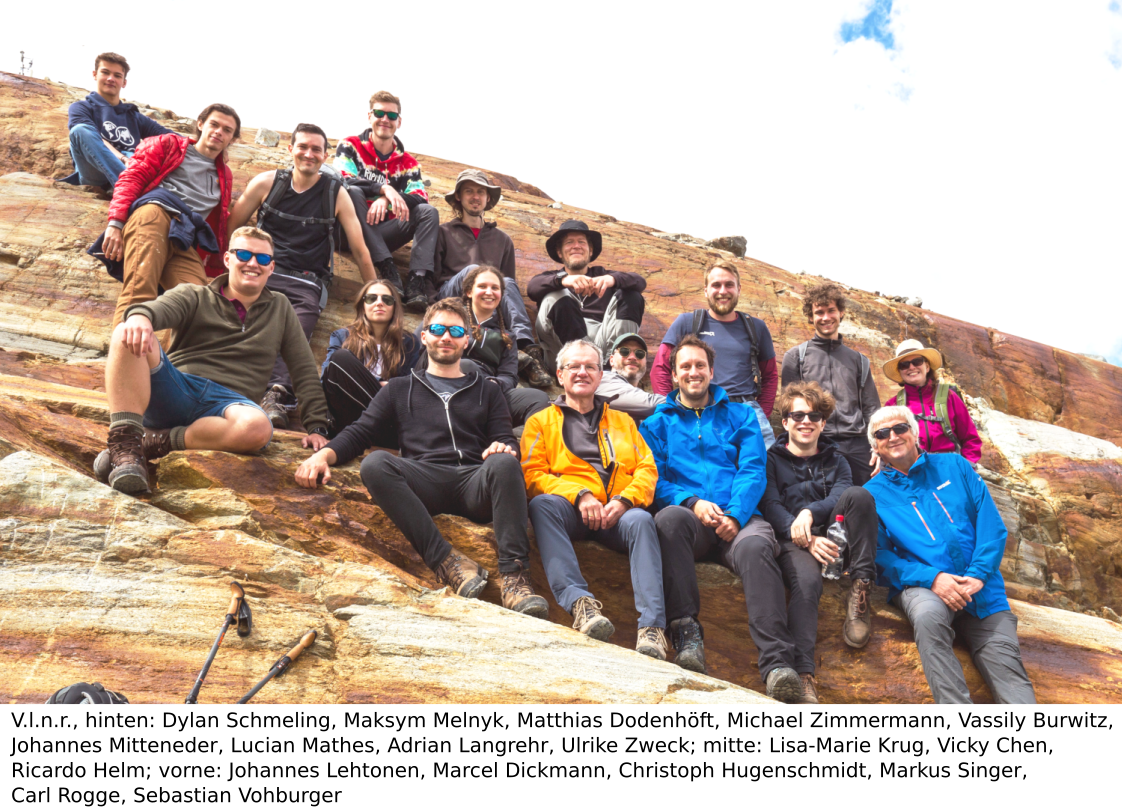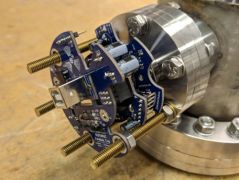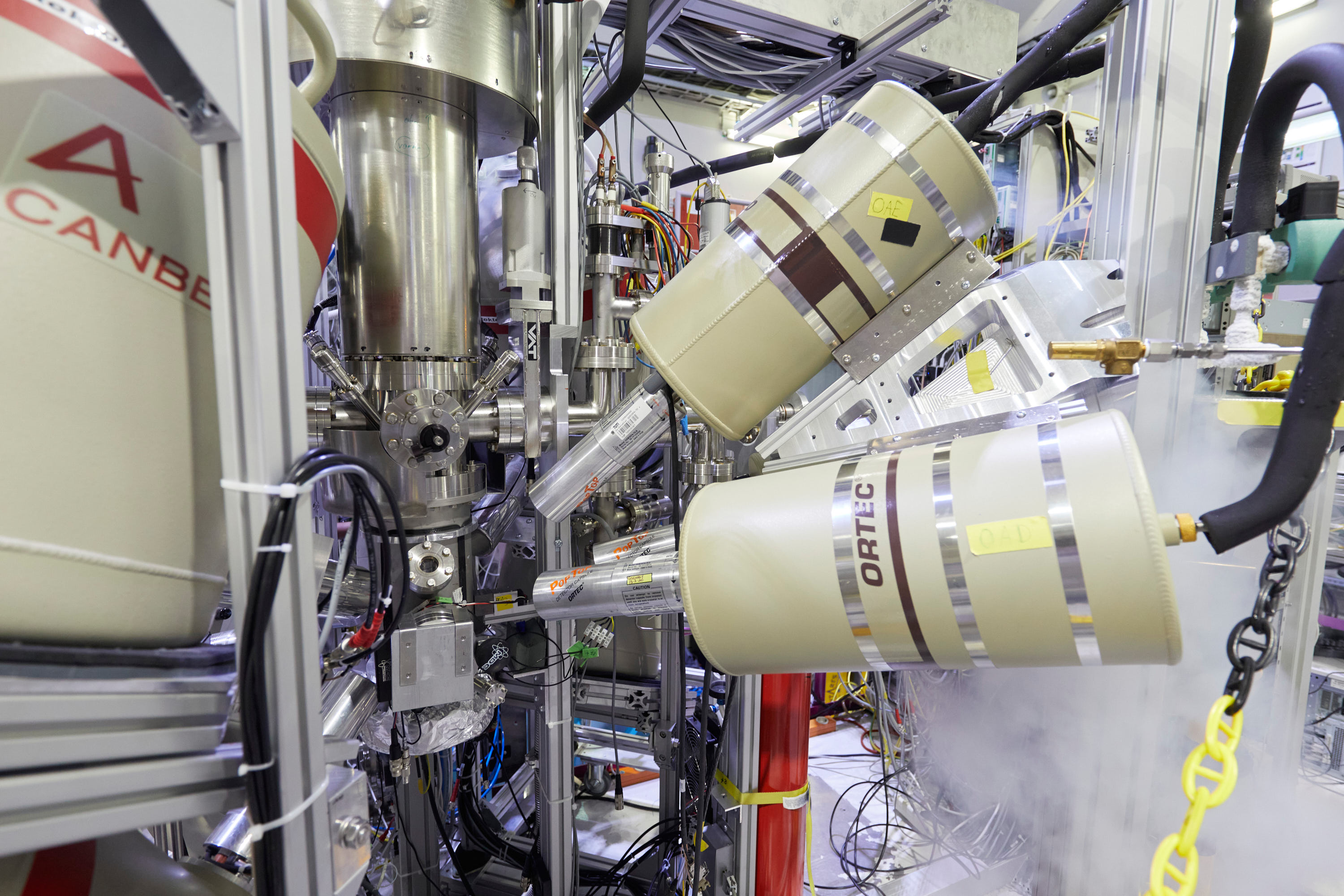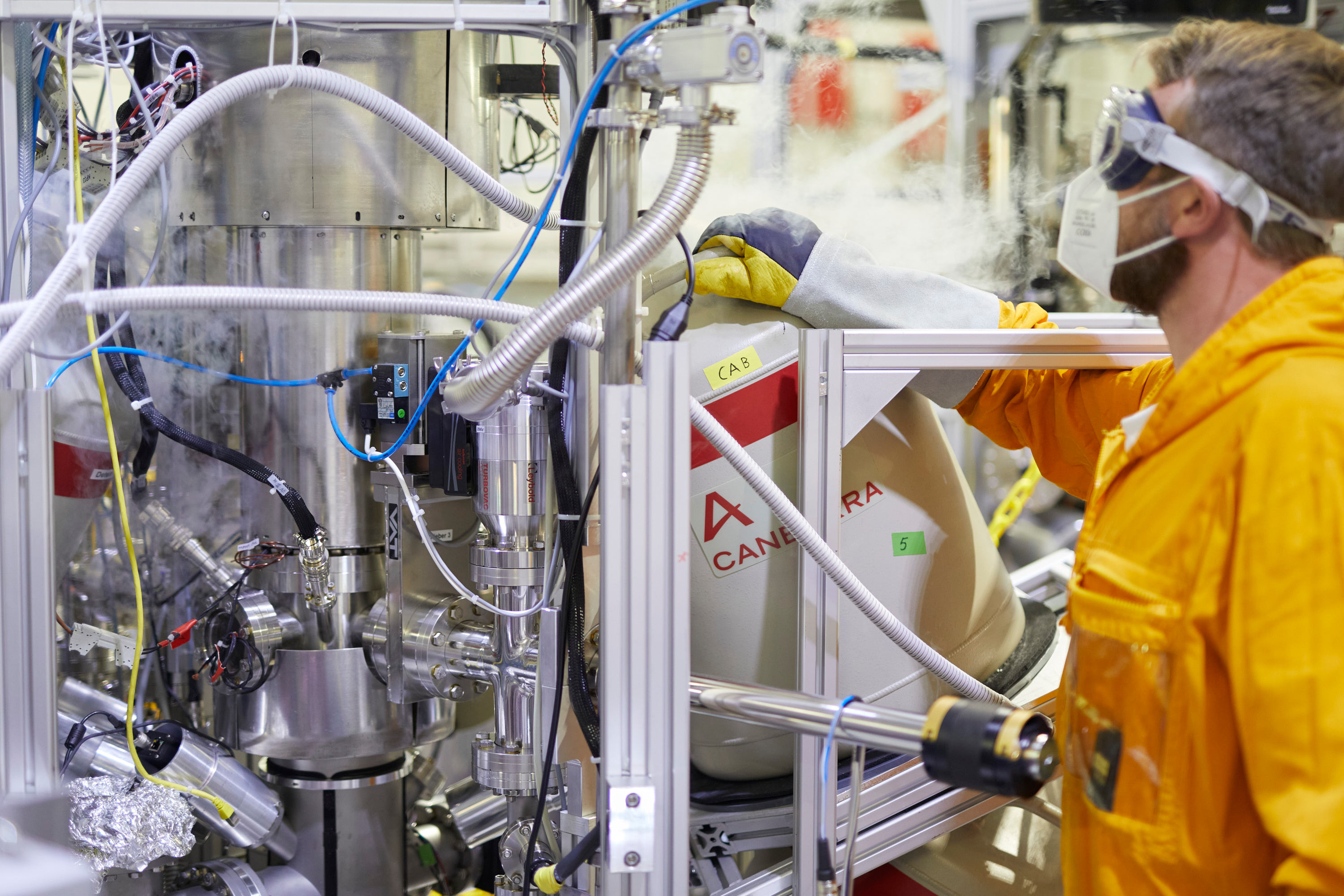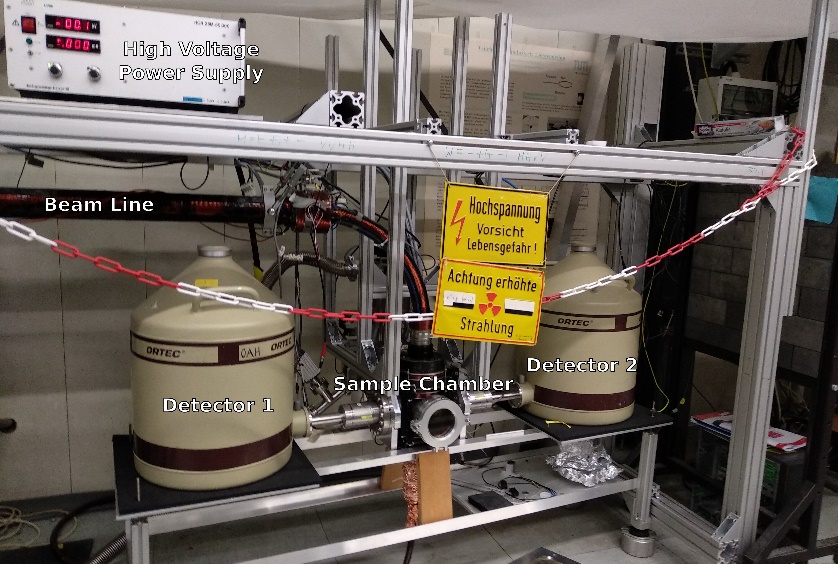MLZ is a cooperation between:
 > Technische Universität München
> Technische Universität München > Helmholtz-Zentrum Hereon
> Helmholtz-Zentrum Hereon
 > Forschungszentrum Jülich
> Forschungszentrum Jülich
MLZ is a member of:
 > LENS
> LENS > ERF-AISBL
> ERF-AISBL
MLZ on social media:

MLZ (eng)
Lichtenbergstr.1
85748 Garching
News Regarding ‘Physics with Positrons’
*** News: ICPA21 to be Hosted by the TUM Research Group Physics with Positrons in 2028 ***
The 21st International Conference on Positron Annihilation (ICPA21) will be held Sept 10 – 15, 2028 at the Technische Universität München, Garching, Germany. The ICPA series was initiated in 1965 dedicated to the study and application of positron and positronium annihilation. This triennial event attracts top researchers from physics, materials science, chemistry, and biomedical engineering to present cutting-edge developments in positron research. ICPA21 will showcase the latest breakthroughs in positron science, spanning from fundamental research to applied material diagnostics. This global gathering brings together a vibrant community of young researchers and established experts working at the exciting interface between antimatter and matter. Key topics include advanced positron annihilation spectroscopy, defect characterization in solids, positronium chemistry, positron beam techniques, and innovative applications in semiconductors, porous systems, and biological imaging. With special focus on emerging frontiers—like AI-assisted data analysis and antimatter studies at facilities such as CERN—ICPA21 offers a platform for bold ideas and cross-disciplinary collaboration. By bridging theory, experiment, and application, ICPA21 promises to be a catalyst for scientific discovery and technological innovation.Research with Positrons in 2025
ICPA20 in Takamatsu, Japan
From June 1–6, 2025, members of our group attended the 20th International Conference on Positron Annihilation (ICPA20) held in Takamatsu, Japan. The event brought together around 125 scientists from across the globe to discuss recent advances in positron physics and its applications. Our team contributed actively to the scientific program with three posters and three talks.Poster Award for Maximilian Suhr at the DPG Spring Meeting 2025
We congratulate Maximilian Suhr from the TUM research group “Physics with Positrons” on winning the Poster Prize of the Fachverband KFM at the DPG Spring Meeting 2025 in Regensburg! His poster, titled “Surface and near-surface positron annihilation spectroscopy at very low positron energy,” showcased recent results obtained with the newly developed SLOPE instrument and was recognized for its clarity, innovation, and scientific relevance.The DPG Spring Meeting of the Condensed Matter Division (SKM) is one of the largest physics conferences in Europe, bringing together thousands of researchers to exchange ideas and present their latest work. This year, the event was held in Regensburg from March 16th to 21st.
Research with Positrons in 2024
WE-Heraeus retreat “Exotic States and Annihilation of Antiparticles”
The retreat on “Exotic States and Antiparticle Annihilation” took place from 16 September to 19 2024 at the Dortmunder Hütte in Kühtai, Austria, organized under the leadership of Prof. Christoph Hugenschmidt (TUM). 17 participants from four different research groups (TUM, UniBWM, University of Würzburg, and IPP Garching) attended despite challenging weather conditions, including floods and snowfall. The scientific program began after a brief welcome and offered ample time for presentations, discussions, and new ideas. The relaxed and lively Q&A sessions led to productive exchanges about current research topics and plans for future measurements and instrumental developments. A key highlight was the excursion to a nearby summit on the third day, successfully completed despite the snowfall. The evening gatherings, especially the PowerPoint Karaoke and the Heraeus evening, were also well-received and contributed to the good atmosphere among the participants. The retreat concluded with a summary of the presentations and a discussion on the future of positron research. In a final moderated session, all participants gave positive feedback and desired to repeat the event. The retreat was particularly valuable for the younger participants, offering deep insights into scientific practice. Thanks to the Wilhelm and Else Heraeus Foundation for their financial support. ZeitplanPSD Poster Price for Danny Russell
Dr. Danny Russell from the TUM research group „Physics with Positrons“ won the 1^st prize in the poster competition at the International Workshop on Positron Studies of Defects 2024 (PSD-24) with his contribution “Modeling backscattered positron capture at the coincidence Doppler broadening spectrometer” — Congratulations!The PSD conferences occur every three years and deal with all kinds of experimental and theoretical positron studies of defects in semiconductors, metals, oxides, etc., as well as in complex and/or layered materials. In 2024, PSD-24 was held in Como, Italy, from 1 September to 6 2024, with a preparatory summer school, “Alfredo Dupasquier,” in Brunate from 31 August to 1 September.
Research with Positrons in 2022
WE-Heraeus-Klausurtagung “Antimaterie: Positronen in der Grundlagenforschung und Materialphysik”
Die Klausurtagung zum Thema „Antimaterie: Positronen in der Grundlagenforschung und Materialphysik“ fand von 5. bis 8. Juli im Stubaital auf der Dresdner Hütte in 2308 m Höhe statt und wurde von der Arbeitsgruppe “Physik mit Positronen” unter der Leitung von Prof. Christoph Hugenschmidt ausgerichtet. Alle 18 Teilnehmer aus insgesamt drei verschiedenen Arbeitsgruppen (TUM, UniBWM und IPP) hielten Vorträgen über Ihre Forschungsarbeiten, wobei die jüngsten Mitglieder (Praktikanten und Werkstudenten) über frei gewählte IG-Nobelpreise berichteten. Die anschließenden Fragerunden arteten nicht selten zu lebhaften Diskussionen aus und resultierten oft in gewinnbringenden neuen Ideen und Denkanstößen. In den geplanten Diskussionsrunden zum fachlichen Austausch wurden Erfahrungen geteilt, aktuelle Forschungsthemen bewertet sowie Pläne für zukünftige Messungen und instrumentelle Weiterentwicklungen diskutiert. Ein besonderes Highlight war am zweiten Tag die Exkursion zum Stubaier Gletscher, wo man beim Rundgang durch eine Gletscherhöhle die verschiedenen Eisschichten und Einschlüsse bestaunen konnte. Auch die Wanderung auf den Egesengipfel am dritten Tag und die allabendlichen Zusammenkünfte kamen bei den Teilnehmern sehr gut an – insbesondere das PowerPoint-Karaoke (Heraeus-Abend) sorgte für eine ausgelassene Stimmung. Der letzte Tag begann mit einem Überblick der geplanten und geförderten Projekte vorgestellt von jeweils einem Vertreter der drei Arbeitsgruppen. Nach einer kurzen Exkursion zur Zukunft der Positronenforschung weltweit, beschloss Prof. Christoph Hugenschmidt die viertägige Klausurtagung mit einer Zusammenfassung. Nach nun mehr als zwei Jahren ohne persönliche Zusammenkünfte und Konferenzen wurde die Klausurtagung von allen Teilnehmern als sehr erfrischend, wissenschaftlich faszinierend und fachlich gewinnbringend empfunden. Besonders für die jüngeren Werkstudenten und Bacheloranden bot die Klausurtagung eine Möglichkeit, tiefere Einblicke in das Forschungsfeld und die wissenschaftliche Praxis im Allgemeinen zu erlangen. Wir danken der WE-Heraeus-Stiftung für die finanzielle Unterstützung dieser Klausurtagung. ZeitplanResearch with Positrons in 2021
For the research with positrons the year 2021 was exceptional with respect to several aspects. Positron beam experiments with external users at NEPOMUC could not be performed due to the reactor shut down of FRM II; but also doing in-house research in the field of positron physics was challenging. Nevertheless, a high number of students has successfully graduated in 2021: Seven Bachelor and one Master students as well as two doctoral students finished their thesis in our TUM research group Physics with Positrons. As elucidated below, besides experiments with a “small” positron beam and beta emitters we pursued several instrumental developments and upgrades at the spectrometers. Organizationally, our research group formerly hosted at the Chair E21 of Prof. Peter Böni who is retired in April 2021 has moved to MLZ. We also migrated and updated the website of the TUM research group Physics with Positrons to here: https://mlz-garching.de/positrons.A Resilient Vacuum Control System for the Positron Beam Line
The complex (ultra-high) vacuum system of the positron beam line facility at NEPOMUC comprises dozens of pumps, numerous vacuum monitors and almost a hundred valves. While the machine is in operation it needs to be monitored 24/7 and promptness in the reaction to any disruptive event, such as a power cut or a component failure, is of the foremost importance in determining the time required by the system to recover. We have integrated the control of all the critical beamline vacuum components into a single control interface operated by a linux-based server named Vanitas. The main design goal of the new vacuum control system is to provide resilience, that is to be able to recover automatically from the widest possible set of different failure modes and, if possible, to restore operation without the need of a human operator intervention. The custom software of the server allows remote monitoring and operation of the vacuum system, automation of the remote operation and provides a continuous record of the pressure in the beamline. On top of that, the new system records further system relevant parameters such as the temperature in the beam tube and the presence of environmental magnetic fields that might lead to deterioration of the beam quality.Novel Type of Positron Beam Monitors
For as long as experiments in ultra-high vacuum have been performed, it remains demanding to operate electronic components in vacuum – indeed the bulky electronics of mid-late 20th century would have been completely incompatible with maintaining the quality of a high vacuum. But the 21st century gifted us with a new selection of highly miniaturized ceramic-based components, opening the door to the development of vacuum-compatible electronics. At NEPOMUC we are now developing novel techniques to realize electronic devices which are compatible with ultra-high vacuum. This opens the door to the possibility of performing ever-increasing complex manipulations of targets in positron-based experiments, and the development of a novel class of beam monitors. During the course of the last year we have employed our vacuum compatible electronics to develop a Faraday-cup-based positron beam monitor, the first of which will be installed on the NEPOMUC beam line in early 2022. The possibility of performing high bandwidth measurement of sub-picoampere currents was rendered possible only by the possibility of pre-amplifying the signal directly in the vacuum chamber, in the closest proximity to the pickup electrodes. The readout electronics is connected directly at the vacuum feedthroughs as shown here:Coincidence Doppler-Broadening Spectrometer – CDBS
The coincidence Doppler-broadening spectrometer at NEPOMUC has been upgraded with regard to several sub-systems. (i) The readout of the detectors is done by multi-channel analyzers with built in signal processing. In the signal processing code dozens of parameters need to be adjusted in order to optimize the countrate dependent energy resolution of the systems. This parameter setting was usually done by hand for each detector at a time. With the upgrade of the detector calibration routine, theses parameters are now optimized automatically for all detectors in parallel. The new optimization code was tested by performing multiple test runs using a Na-22 and Eu-152 gamma-source in the device. It was demonstrated that an improved energy resolution has been achieved and the according operator hours required were greatly reduced. (ii) Major parts of the detector cooling system of the CDB spectrometer have been replaced by a new ones. The high-purity Germanium detectors in use at the CDBS can only operate when cooled to liquid nitrogen (LN) temperatures. In order to enable the operation of a large number of detectors, i.e., currently ten detectors are operated simultaneously, a new modular LN refilling system was installed and optimized (see Figure 2). (iii) A new insert for measurements on gaseous samples was constructed, built and tested in a mockup. This pre-study serves final design of a sample cell within the scope of an (applied) project in order to enable in operando positron beam experiments on samples in humid or/and gaseous atmosphere. Although no reactor based positron beam was available in 2021 it never the less was possible to conduct CDB measurements by using a beta+ emitter. The beta+ emitter, Na-22, was mounted between two identical samples in a sandwich geometry positioned in the center of the sample chamber of the CDB spectrometer. In total, the measurement campaign ran for four months. The samples measured include a set of reference samples to benchmark the current device configuration as well as a set of Al alloys in which the behaviour of Cu precipitates after the application of different temper processes was studied.Tabletop Positron Beam
Since 2020, the research group Physics with Positrons operates the monoenergetic laboratory positron beam for Doppler-broadening spectroscopy (DBS). Instead of exploiting the pair production process after neutron capture – as done at NEPOMUC / FRM II – it is based on the beta+ emitter Na-22. Despite its lower intensity, the availability of a mono-energetic positron beam independent from reactor operation, turned out to be indispensable to perform experiments in the scope of master and bachelor theses. In this setup, samples can be biased up to 40 kV allowing extensive studies on crystal quality or defect distribution from the surface up to depth of a few µm. With new electronic readout components recently installed, the instrument is capable of recording so-called depth profiles within about two days. It is therefore suited for both pre-studies for the CDB spectrometer and for new experiments with respect to (depth dependent) defect distributions. The laboratory beam is in routine operation (~ 60 measurements in 2021) and has been applied to, e.g., a series of W single crystals from within our collaboration with the Max-Planck Institute for Plasma Physics (DFG project: HU 978/18-3).Theses Finished in 2021
PhD Theses: Injection of Positrons into a Dipole Trap for Creation of an Electron-Positron Plasma Markus Singer, October 2021 Production and investigation of positronium converter targets in transmission mode Benjamin Rienäcker, May 2021 Master Thesis: Novel Analysis Software for Coincidence Doppler Broadening Spectroscopy Leon Chryssos, TUM, October 2021 Bachelor Theses: Faraday-Cup-Based Position-Sensitive Positron Beam Monitor Michael Zimmermann, TUM, October 2021 Signal Readout Optimization for Germanium Detectors Max Viehl, TUM, October 2021 Temperature Dependent 2D-ACAR Spectroscopy of Pr2NiO4.25 and FEM Modelling of Temperature in a 2D-ACAR Setup Christoph Oswald, TUM, October 2021 Upgrade of a Digital Spectrometer for Efficient Measurement of the Positron Lifetime Louis Hohmann, TUM, October 2021 Setup of a Pressure Cell for Doppler-Broadening Spectroscopy of the Positron Annihilation-Line in Gases Muriel Schur-Willkens, TUM, October 2021 Development of an Analysis Tool for Depth Profiling with Positrons Michael Göldl, TUM, October 2021 Optimierung eines digitalen Messsystems für Positronen-Annihilations-Lebensdauerspektroskopie und Messung von Polymeren Nicolas Thomae, FH München, February 2021Head of Research Group
Prof. Dr. Christoph Hugenschmidt
Phone: +49 (0)89 289-14609
E-Mail: christoph.hugenschmidt@frm2.tum.de
Physics with Positrons
> Home
> News
> Team
> Research
> Publications & Presentations
> Teaching
> Photo Gallery
> Funding
> Useful Links
MLZ is a cooperation between:
 > Technische Universität München
> Technische Universität München > Helmholtz-Zentrum Hereon
> Helmholtz-Zentrum Hereon
 > Forschungszentrum Jülich
> Forschungszentrum Jülich
MLZ is a member of:
 > LENS
> LENS > ERF-AISBL
> ERF-AISBL
MLZ on social media:







